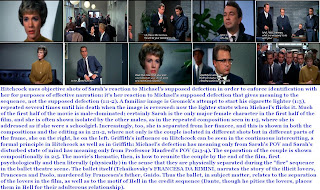TORN CURTAIN
THE SCHEDULED FILM for 23 October 2009 is Alfred Hitchcock's Torn Curtain (1966). Alfred Hitchcock, of course, is one of the world's most famous directors. Hitchcock was the first American director the French critics praised as being an "auteur," a director whose personal vision controlled every film he made and whose films reflected consistent themes and a point of view. But long before the "Auteur Theory" of directorial signatures (the film should reflect the maker's personality, as do novels or symphonies), Hitchcock was world famous, getting his picture on promotional posters before many directors even got their names on them. Even today his films are marketed on DVDs mainly based on his name or picture, regardless of who stars in them.
But Torn Curtain is one of the least successful of Hitchcock's films and shows a decline on many levels, including visuals, acting, screenplay, and musical underscore. In fact the film is at least as famous for the row that Hitchcock had with his compoer, the legendary Bernard Herrmann, with whom Hitchcock had had a ten-year partnership. Apparently dissatisfied with Herrmann's "unmelodic" score, Hitchcock rejected it, fired Herrmann and never worked with him again. Instead he hired John Addison for a new score, which is the score heard today. But Herrmann's score is also available on CD, and comparing the two scores with their respective scenes allows a great education in film underscoring.
Actually, Addison's score is reasonably effective in the film and, in some cues (such as the Telegram cue) surpasses Herrmann's cues. In fact, Herrmann's entire score fails to enhance the film and merely reflects it. This is not what a great underscore should do. Many music critics think otherwise and believe Herrmann's score would have helped the film. (The CD covers to both scores are attached.)
The most controversial scene in the film is Gromek's murder, which Hitchcock insisted should play without an underscore. However both Herrmann and Addison wrote underscore cues for the sequence, neither of them used in the final edit. Both cues can be heard on the respective CD releases of the two Torn Curtain musical scores.
Torn Curtain, though inferior Hitchcock, is valuable to study on many levels. First, the student can understand the studio pressure even reputable directors such as Hitchcock have to endure in order to survive in what is essentially a commercial business. Movies have got to make money and return their investments. Hitchcock's previous movie, Marnie, was not commercially successful at the box office, so Hitchcock needed a solid box office hit.
Because Bernard Herrmann wrote scores without song hits in them that could help sell the movie, Hitchcock at least partly blamed Herrmann for the failure of his last movie. Desperate for a song hit, he hired John Addison instead. In fact, Addison was unable to write a pop hit and accepted a pop song by Livingston and Evans, who also wrote "Que Sera" for another Hitchcock film. As it turned out, that song was not a hit either, but Addison did incorporate the melody in variation form in his underscore cues for the lovers.
In addition to his musical problems, Hitchcock was forced to accept two current superstars, Paul Newman and Julie Andrews, for his leading roles. As it turned out, both were unable to deliver convincing performances. Newman was still enthralled by his Method studies and turned in a self-conscious, heavy, and often wooden performance, missing the point of the genre called "spy thriller." Andrews lacked the sex appeal and allure of a typical Hitchcock heroine.
Paul Newman's performance in the film is a lesson in the limits of Method Acting, which can produce performances as mannered as the more traditional kind of stencil acting, such as one finds in Gregory Peck's performance in To Kill a Mockingbird. In fairness to Newman he increasingly grew out of his Method acting mannerisms in his later work and developed a more behavioral style of acting, becoming the part instead of adapting the part to himself.
Other problems with Torn Curtain include a half-baked screenplay, poor characterizations that allowed for many flat characters (actually, only the Paul Newman character is drawn in some depth), and a too heavy reliance on cameo roles, as in the Polish would-be emigre and Gromek.
Despite its reputation as one of the great set pieces in Hitchcock's cinema, the murder of Gromek seems as caricatured as many other moments in the film. First, it's unbelievable that a Physics professor would be able to overpower a professional East German agent. Second, Gromek is drawn in such one-dimensional comic strokes that it's difficult to take the scene seriously as the murder of a human being. Gromek never seems real in the film, but just a comic book sketch of a spy, without background or history. So, regardless of Hitchcock's intent to show how difficult it is to kill a person (compared with the typical Hollywood film) the scene falls flat because the murder victim is flat to begin with.
The scene with the Polish would-be emigre is one of the most pointless scenes in all of Hitchcock's films, especially since the film needed editing anyway. The puzzlement of the stars, Newman and Andrews, is apparent throughout the scene, and they seem at a loss to know how to act the scene.
There are still good moments in the film, including the opening sequence with the telegram (a highlight of John Addison's underscore cue), the bus sequence, and the theatrical ballet sequence. In any case, any film can be a source of learning about movies.



















No comments:
Post a Comment